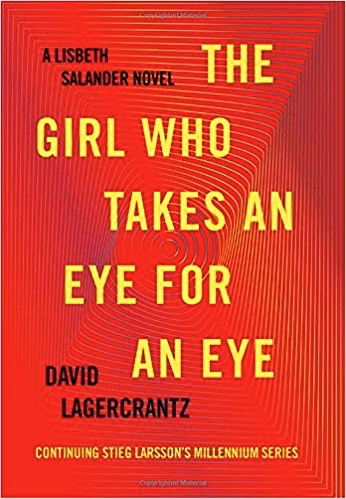“[Seven-thirty p.m.] was the most dangerous time at Flodberga Prison. [That] was when the daily freight train thundered past; the walls shook and keys rattled and the place smelled of sweat and perfume. All the worst abuses took place then, masked by the racket from the railway…just before the cell doors were shut. Salander always let her gaze wander back and forth….Someone was slapping Faria Kazi…The abuse had been going on for a long time and had broken her will to resist.”
 Lisbeth Salander is back in this continuation of the Millenium series started by Swedish author Steig Larsson and continued, following Larsson’s death in 2004, by David Lagercrantz. The raw energy and the violence of the three Larsson thrillers are more muted in the work of Lagercrantz, who was hired by Larsson’s heirs to continue the series, writing The Girl in the Spider’s Web and now The Girl Who Takes an Eye for an Eye. Lagercrantz’s reliance on Salander, a damaged and reclusive computer hacker, and Mikael Blomquvist, a famed investigator and the founder of Millenium Magazine, to control the action is less obvious here than in Larsson’s novels, and he carefully includes identifying information for many of the earlier characters who repeat within this series, even including a helpful character list at the beginning. The complexity of the plot of this novel is clear early on if one looks at the character groupings within that character list: Lisbeth Salander and Mikael Blomqvist, listed separately, are followed by those in Lisbeth’s violent and sadistic family; those who have had an effect on Lisbeth’s adult life, for better or, more often, for worse; the organizations with which Lisbeth sometimes has contact – a thuggish motorcycle gang, an elite group of hackers, and a secret police faction with its own agenda; and the legitimate police who have investigated her. In the course of this novel, over two dozen new characters also make their appearances, as Lisbeth and Blomqvist, while still involved in the plot, take more limited roles and share the action with many others.
Lisbeth Salander is back in this continuation of the Millenium series started by Swedish author Steig Larsson and continued, following Larsson’s death in 2004, by David Lagercrantz. The raw energy and the violence of the three Larsson thrillers are more muted in the work of Lagercrantz, who was hired by Larsson’s heirs to continue the series, writing The Girl in the Spider’s Web and now The Girl Who Takes an Eye for an Eye. Lagercrantz’s reliance on Salander, a damaged and reclusive computer hacker, and Mikael Blomquvist, a famed investigator and the founder of Millenium Magazine, to control the action is less obvious here than in Larsson’s novels, and he carefully includes identifying information for many of the earlier characters who repeat within this series, even including a helpful character list at the beginning. The complexity of the plot of this novel is clear early on if one looks at the character groupings within that character list: Lisbeth Salander and Mikael Blomqvist, listed separately, are followed by those in Lisbeth’s violent and sadistic family; those who have had an effect on Lisbeth’s adult life, for better or, more often, for worse; the organizations with which Lisbeth sometimes has contact – a thuggish motorcycle gang, an elite group of hackers, and a secret police faction with its own agenda; and the legitimate police who have investigated her. In the course of this novel, over two dozen new characters also make their appearances, as Lisbeth and Blomqvist, while still involved in the plot, take more limited roles and share the action with many others.
As the novel begins, Lisbeth is in Flodberga Prison, serving two months for violent actions she committed in the previous novel when she rescued a severely autistic child and hid him for his own safety. Though Blomqvist and his sister Annika Giannini, Lisbeth’s lawyer, were frustrated by Lizbeth’s failure to defend herself in court, she did not care. Prison, she thought, would offer her more time to be on her own, working without interference or threats from the outside world. Within twenty-five pages, however, Lisbeth is involved in trying to right new injustices within the prison. A young woman, Faria Kazi, from Bangladesh, someone so emotionally frail that Lizbeth regards her as a “human wreck,” is being abused by a female gang leader, “Benito” Andersson. The power mad “Benito” rules the unit, despite the presence of guards and the awareness of the prison warden and prison governor. Using her own skills, both physical and intuitive, Lisbeth manages to defuse some of these issues while also ensuring her own privilege of using a prison computer for an extended period of time one evening. She has been investigating some files from the past which she believes may explain aspects of her own early life and background.
 Another plot line involves Blomqvist, who visits the imprisoned Lisbeth regularly each week. He has been investigating a hacker attack on financial markets in Brussels, especially as they impact a particular investment company, Alfred Ogren Securities. Blomqvist has noticed something strange on a recent video, involving an Alfred Ogren officer whose own life soon comes under scrutiny. Lisbeth’s former guardian and great friend, Holger Palmgren, also appears here. Palmgren has some issues regarding Lisbeth’s past, and though he is dying and in great pain, he has managed to visit her once. He has more papers related to her past – papers that she is desperate to study. At this point, the many coincidences and accompanying flashbacks begin, each flashback going back to eighteen months earlier than the current action. The flashbacks add information to what the author has already presented through the action, prolonging the suspense and sometimes connecting the various subplots.
Another plot line involves Blomqvist, who visits the imprisoned Lisbeth regularly each week. He has been investigating a hacker attack on financial markets in Brussels, especially as they impact a particular investment company, Alfred Ogren Securities. Blomqvist has noticed something strange on a recent video, involving an Alfred Ogren officer whose own life soon comes under scrutiny. Lisbeth’s former guardian and great friend, Holger Palmgren, also appears here. Palmgren has some issues regarding Lisbeth’s past, and though he is dying and in great pain, he has managed to visit her once. He has more papers related to her past – papers that she is desperate to study. At this point, the many coincidences and accompanying flashbacks begin, each flashback going back to eighteen months earlier than the current action. The flashbacks add information to what the author has already presented through the action, prolonging the suspense and sometimes connecting the various subplots.

Blomqvist plans to hear a talk at the Fotografiska Museet by someone he suspects of being an innocent participant in the Genetic Study conducted 25 years ago.
Eventually, the files from the “Registry for the Study of Genetics and Social Environment,” being perused separately by Lisbeth and Blomqvist, introduce new characters whose connections to existing characters come as little surprise, while their danger to the “scientists” involved in secret genetic studies becomes obvious. By this point, over twenty-five years have passed since research began on a select group of children, and all that remains is to keep track of the test subjects, several of whom, including Lisbeth, are involved in the action and flashbacks here. The implications of this study could bring down high officials in business and in government. Lisbeth, “the girl who takes an eye for an eye,” is particularly vengeful. The conclusion, which has plenty of action, also involves some violence, though it is less grotesque, less “juicy,” than what appears in the Larsson novels. Some parts of the conclusion even suggest that there are alternatives to the “eye for an eye” mentality which permeates the series.

Click to enlarge. St. George and the Dragon by Sten Sture in 1489 is something that especially impresses Lisbeth, even inspiring her to think in new directions. Note the woman in the bottom left. Photo by Nairon.
Dedicated readers of the series to date may find that this novel feels a bit “old.” Lisbeth is a difficult character to like, though it is easy to feel sorry for her, and her need for real emotional help is obvious. Whether Lagercrantz has future plans to help her remains to be seen. In the meantime, much credit is due to him for keeping the large cast of characters, many from previous novels, on track in this one. I was disappointed, however, in the amount of coincidence used here to make convenient connections among the subplots. The flashbacks, the first of which begins one-third of the way through the book, become increasingly prevalent – and annoying – with nine or ten of them in the last half of the book alone. While these artificial devices can be used to prolong suspense and add bits of information slowly, they also prevent the kind of identification a reader usually gains from “sharing” the characters’ lives as they actually happen. In one powerful and memorable incident, however, Lisbeth shares her feelings for the first time ever, commenting on Sten Sture’s sculpture of St. George and the Dragon, which includes a female observing the killing of a fire-breathing dragon. “I had never seen [this statue] as a monument to a heroic deed,” Lisbeth says, “but rather as a representation of a terrible assault….[But] the same fire that can turn us into ashes and waste…can become something totally different; a force which allows us to fight back,” she believes, a new idea for Lisbeth and perhaps the future.

The af Chapman Youth Hostel, located in an old sailing ship, is where a character stayed when he returned to Sweden from overseas. It still operates as a hostel. Photo by Brorsson
ALSO by Steig Larsson: THE GIRL WITH THE DRAGON TATTOO, THE GIRL WHO PLAYED WITH FIRE, THE GIRL WHO KICKED THE HORNET’S NEST.
By David Lagercrantz: THE GIRL IN THE SPIDER’S WEB, THE GIRL WHO LIVED TWICE
Photos: The author’s photo is from http://www.dailymail.co.uk
The photo of the woman in jail appears on https://www.hrw.org/
The Fotografika Museet, where Blomqvist planned to hear a character speak, is here: https://www.pinterest.com
Sten Shure’s 1489 statue of St. George and the Dragon made an enormous impressing on Lisbeth Salander when she noticed the woman in the bottom left. Click to enlarge. https://en.wikipedia.org/
The af Chapman Youth Hostel, where one character stays upon his return to Sweden after a trip overseas, is located on a retired sailing ship and is still being used. https://en.wikipedia.org/

